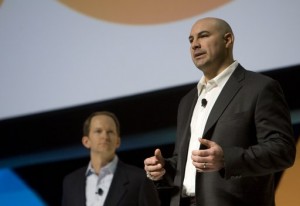For entrepreneurs looking to break into the exploding world of mobile sports application development, having AT&T as a BFF is a no-brainer, according to Joe Tafoya, a former NFL player who is now heading up a mobile content company called Viva! Vision Inc. Viva’s still-in-development app for Dallas Mavericks star Jason Terry was highlighted on stage at the AT&T Developer Summit here Monday, with Tafoya giving a quick demo of the forthcoming app’s ability to give fans lots of content centered around Terry, including training videos that will be available for purchase.
Where AT&T comes in is via links to the cellular giant’s network and payment systems, which will allow people to purchase items from the Jason Terry app by simply clicking and having the charges appear on their monthly cellular bill. In the not too distant past, having access to services embedded deeply into the cellular infrastructure was something small developers could only dream of. Now, up-and-coming players like Viva! Vision can theoretically gain easy links to AT&T’s millions of wireless customers as part of a big push by Ma Bell to help find and partner with the people who are truly innovating on the app development front.
“We looked at a lot of payment systems but being able to use AT&T was a no-brainer,” said Tafoya in a quick interview following the AT&T presentation, citing both the ability to have a quick, easy payment system in the app as well as access to AT&T’s millions of cellular customers.
And while sports and gaming are always at the top of the list of popular mobile apps, AT&T is of course extending its new programs to developers of all stripes, from in-car applications to enterprise apps to apps that let you compile grocery lists. Part of the company’s push Monday included new programs to make using its APIs (application programming interfaces) easier for developers, as well as programs to help developers get their apps noticed by more consumers and companies.
“Our goal is to make it easier for [developers] to navigate the mobile ecosystem,” said Ralph de la Vega, CEO of AT&T Mobility, during the Summit’s keynote address. For some developers like Viva! Vision’s Tafoya, that’s a goal that’s already happening.










